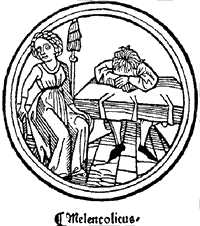
On the Causes of Melancholy

At the time that Shakespeare was writing Hamlet, the most important work on the subject of melancholy was Dr. Timothy Bright's Treatise of Melancholy. Two editions of this work came out in 1586, and a third was to appear in 1612. Bright states that melancholic humors, being cold by nature, settle in the spleen which causes vapors to rise past the heart to the brain. This process proves to be both disheartening and the cause of unreasonable behavior.
| The perturbations of melancholy are for the most parte, sadde and fearful,
and such as rise of them: as distrust, doubt, diffidence, or dispaire,
sometimes furious and sometimes merry in apparaunce, through a kinde of
Sardonian, and false laughter, as the humour is disposed that procureth
these diversities. Those which are sad and pensive, rise of that melancholick
humour, which is the grossest part of the blood, whether it be iuice or
excrement, not passing the naturall temper in heat whereof it partaketh,
and is called cold in comparison onely. This for the most part is setled
in the spleane, and with his vapours anoyeth the harte and passing vp
to the brayne, counterfetteth terrible obiectes to the fantasie, and polluting
both the substance, and spirits of the brayne, causeth it without externall
occasion, to forge monstrous fictions, and terrible to the conceite, which
the iudgement taking as they are presented by the disordered instrument,
deliuer ouer to the hart, which hath no iudgement of discretion in it
self, but giuing credite to the mistaken report of the braine, breaketh
out into that inordinate passion, against reason. - Timothy Bright, A Treatise of Melancholie, (1586), Facsimile Text Society, New York, 1940. p.102. |
Shakespeare scholars have made convincing arguments about the likelihood that Shakespeare was familiar with Timothy Bright's work, paying particular attention to Hamlet. Whether Shakespeare knew the actual work is subject to surmise, but it seems quite likely that the understanding of melancholy contained in Bright's work soon gave way to an underlying theory about the affliction which is represented in Hamlet.
| It is natural to conclude that Shakespeare used the Treatise
[of Melancholy] in his task of fitting a ready-made destiny with
a convincing character. With this conclusion, the dates, the popular appeal
of the Treatise, the parallel passages, all agree... Thus, in the
light of Bright's Treatise we get the outlines of a Hamlet of Elizabethan
psychology. This Hamlet is not a puppet of dramatic circumstance, pulled
now by Kyd's strings, and now by Shakespeare's, but a character unified
by the qualities of the melancholy man, as Bright presents them. - Mary Isabelle O'Sullivan, "Hamlet and Dr. Timothy Bright," PMLA v. xl (1926) pp. 678-9. |
With regard to causes, Timothy Bright begins with the assumption that melancholy, like all the other humors, has its first cause in diet.
| As all naturall humours rise of nourishment, so melancholie being a
part of the bloud, from thence it springeth also. - Timothy Bright, A Treatise of Melancholie, 1586, Facsimile Text Society, New York, 1940. p.4. |
Nourishment plays a large part in the process of determining the proportions of the humors, and thus the health and inclinations of the individual. The process of digestion (called concoction ) takes place in three stages. In the first, the stomach produces a whitish fluid called chyle. It is then carried to the liver (a hot organ) where further concoction produces the four primary humors. The heaviest of these, melancholy, is believed to be a sludge which sinks to the bottom and is, therefore, semiexcremental. When the fluids are transported to the heart for further refinement, the purest blood is transformed into the vital spirits which animate and warm the entire body. If the flow of vital spirits is restricted, the blood can degenerate into melancholy. The vital spirits are rarefied into an even subtler vapor in the brain called the animal spirits (Latin anima ) which flows in the nerves just as the vital spirits flow in the arteries and veins.
Here's a list of foods which, according to Timothy Bright, can occasion melancholic humors.
|
vegetable colewarts Meat muscle parts |
kidney |
Needless to say, diet was not thought to be the only cause of melancholy, and, according to common belief, certain emotional causes sat at the top of the list of suspects. Among these were lost or unrequited love, frustrated ambition, and an overheated intellect. These emotional causes will be discussed in the section on the common faces of melancholy.